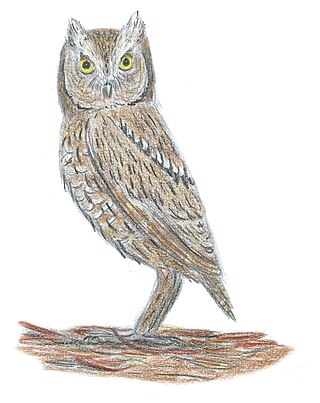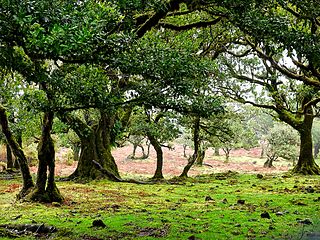
Madeira, officially the Autonomous Region of Madeira, is an autonomous region of Portugal. It is an archipelago situated in the North Atlantic Ocean, in the region of Macaronesia, just under 400 kilometres (250 mi) north of the Canary Islands —Spain—, 520 kilometres (320 mi) west of the Kingdom of Morocco and 805 kilometres (500 mi) southwest of mainland Portugal. Madeira sits on the African Tectonic Plate, although it is culturally, politically and ethnically associated with Europe, with its population predominantly descended from Portuguese settlers. Its population was 251,060 in 2021. The capital of Madeira is Funchal, on the main island's south coast.

The water rail is a bird of the rail family which breeds in well-vegetated wetlands across Europe, Asia and North Africa. Northern and eastern populations are migratory, but this species is a permanent resident in the warmer parts of its breeding range. The adult is 23–28 cm (9–11 in) long, and, like other rails, has a body that is flattened laterally, allowing it easier passage through the reed beds it inhabits. It has mainly brown upperparts and blue-grey underparts, black barring on the flanks, long toes, a short tail and a long reddish bill. Immature birds are generally similar in appearance to the adults, but the blue-grey in the plumage is replaced by buff. The downy chicks are black, as with all rails. The former subspecies R. indicus, has distinctive markings and a call that is very different from the pig-like squeal of the western races, and is now usually split as a separate species, the brown-cheeked rail.
The Ibiza rail is a recently discovered fossil species of rail, described from a late Pleistocene to Holocene cave deposit at Es Pouàs, on the island of Ibiza. Ibiza is in the Pityuses group of the Spanish Balearic Islands in the Mediterranean Sea. The Ibiza rail was a relative of the extant water rail and may be derived from it, but was a bit smaller and stouter, had shorter and more robust hind limbs and shorter wings, with probably reduced its flight capability. Consequently, it might have also occurred on neighbouring Formentera, where no possible locations have been surveyed.
Günther Edmund Maul was a German ichthyologist and taxidermist in Portugal. Maul came to Madeira in December 1930 to work as taxidermist at Museu Municipal do Funchal, which opened to the public in 1933. He was appointed director for the museum in 1940, a post that he held to his retirement in 1979. He, however, continued his research until shortly before his death. He started two journals and opened the museum's aquarium to the public in 1959. He also participated in several expeditions including with the French bathyscaphe Archimède in 1966 and organised the first multidisciplinary expedition to the Salvage Islands in 1963. He was awarded an honorary doctorate from the University of Madeira in 1995.

The Tahiti rail, Tahitian red-billed rail, or Pacific red-billed rail is an extinct species of rail that lived on Tahiti. It was first recorded during James Cook's second voyage around the world (1772–1775), on which it was illustrated by Georg Forster and described by Johann Reinhold Forster. No specimens have been preserved. As well as the documentation by the Forsters, there have been claims that the bird also existed on the nearby island of Mehetia. The Tahiti rail appears to have been closely related to, and perhaps derived from, the buff-banded rail, and has also been historically confused with the Tongan subspecies of that bird.

Rallus is a genus of wetland birds of the rail family. Sometimes, the genera Lewinia and Gallirallus are included in it. Six of the species are found in the Americas, and the three species found in Eurasia, Africa and Madagascar are very closely related to each other, suggesting they are descended from a single invasion of a New World ancestor.
Hungerfordia is a genus of small land snails with an operculum, a terrestrial gastropod mollusk in the family Diplommatinidae endemic to the Republic of Palau. Many of the members of this genus inhabit limestone cliffs or rubble, especially in the Rock Islands (Chelbacheb) in Airai, Koror, and Peleliu states. As of 2022, there are 41 described species in this genus. A series of revisions in 2013 - 2015 described several new species, as well as transferring Palauan members of the genus Diplommatina or Palaina into Hungerfordia.
Hodgens' waterhen is an extinct rail species from New Zealand. Its name commemorates the Hodgen brothers who were owners of the Pyramid Valley swamp where the holotype was discovered. It reached a weight of 280 g and its wings were so reduced that it was unable to fly. It occupied a wide range of habitats, including open forest and grassland along riverbanks.

The Madeiran scops owl is a small extinct owl that once inhabited the island of Madeira in the Macaronesian archipelago off the north-west coast of Africa in the North Atlantic Ocean.
The São Miguel scops owl is a small extinct owl that once inhabited the island of São Miguel, in the Macaronesian archipelago of the Azores, in the North Atlantic Ocean. Its scientific specific name honours the 16th-century Azorean historian Gaspar Frutuoso.

Pteroidichthys noronhai, Noronha’s scorpionfish, is a species of marine ray-finned fish belonging to the family Scorpaenidae, the scorpionfishes. It is found in the central western Pacific Ocean.

Agraeciini is a large tribe of bush crickets or katydids in the conehead subfamily, Conocephalinae.

The Madeira evergreen forests is a laurissilva ecoregion of southwestern Europe. It covers the archipelago of Madeira and some nearby islands in the Atlantic Ocean. Laurel forest, known as Laurisilva of Madeira, once covered the islands. Over centuries the laurel forests were mostly cleared. Madeira's remaining forests are now protected.

The Laurisilva of Madeira is a natural place declared a World Heritage Site by UNESCO in 1999. It is considered a very valuable relic, due to its size and quality, of the laurisilva, a type of laurel forest that was very abundant in the past and is practically extinct today. It is believed to be 90% primordial forest. The paleobotanical record of the island of Madeira reveals that the laurel forest existed on this island at least 1.8 million years ago.
Rallus adolfocaesaris is an extinct species of Rallus that inhabited Porto Santo Island of Madeira during the Holocene epoch.
The Pico rail is an extinct species of Rallus that inhabited Pico Island in the Azores during the Holocene epoch.
The São Miguel rail is an extinct species of Rallus that inhabited São Miguel Island in the Azores during the Holocene epoch.








